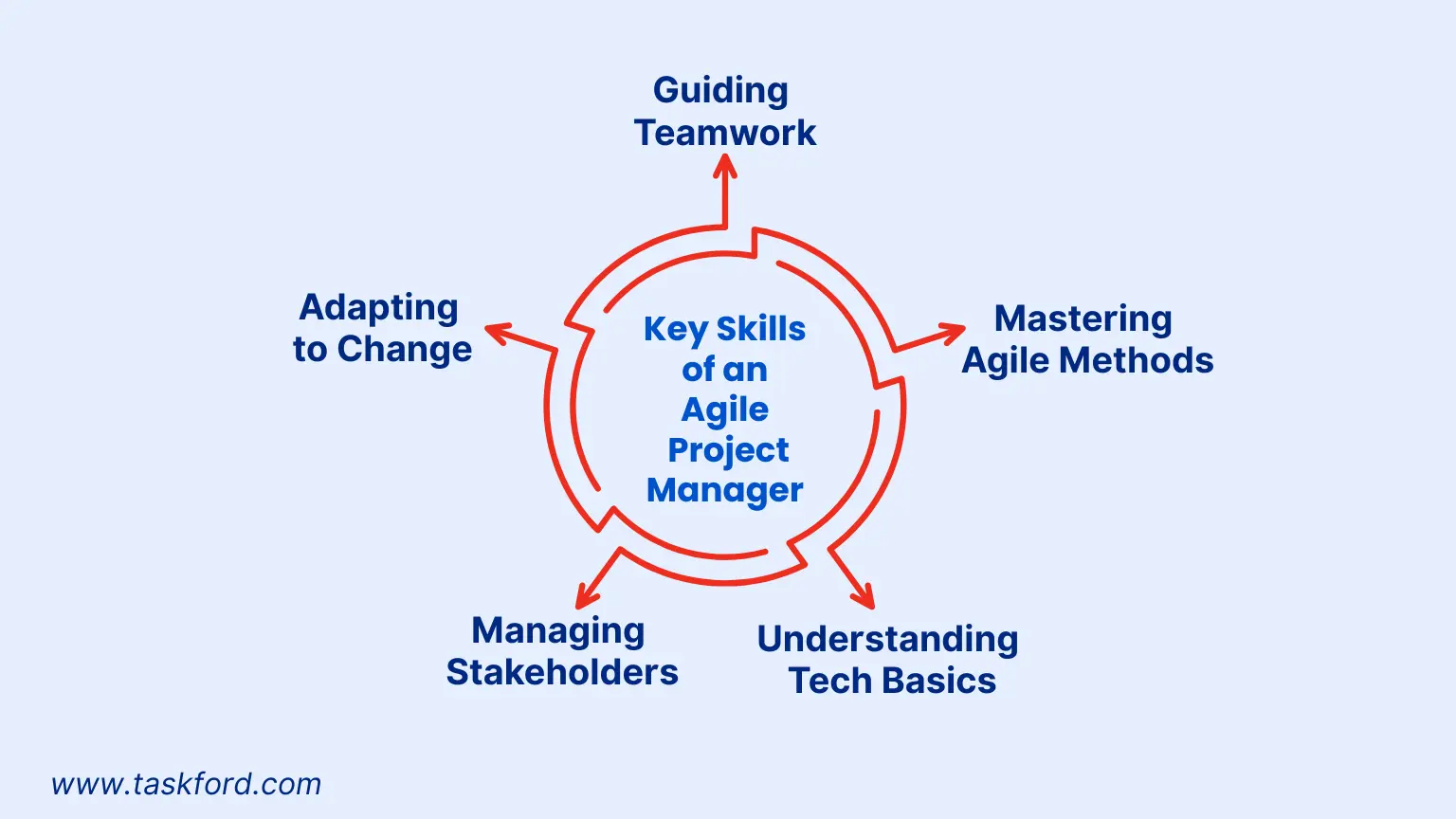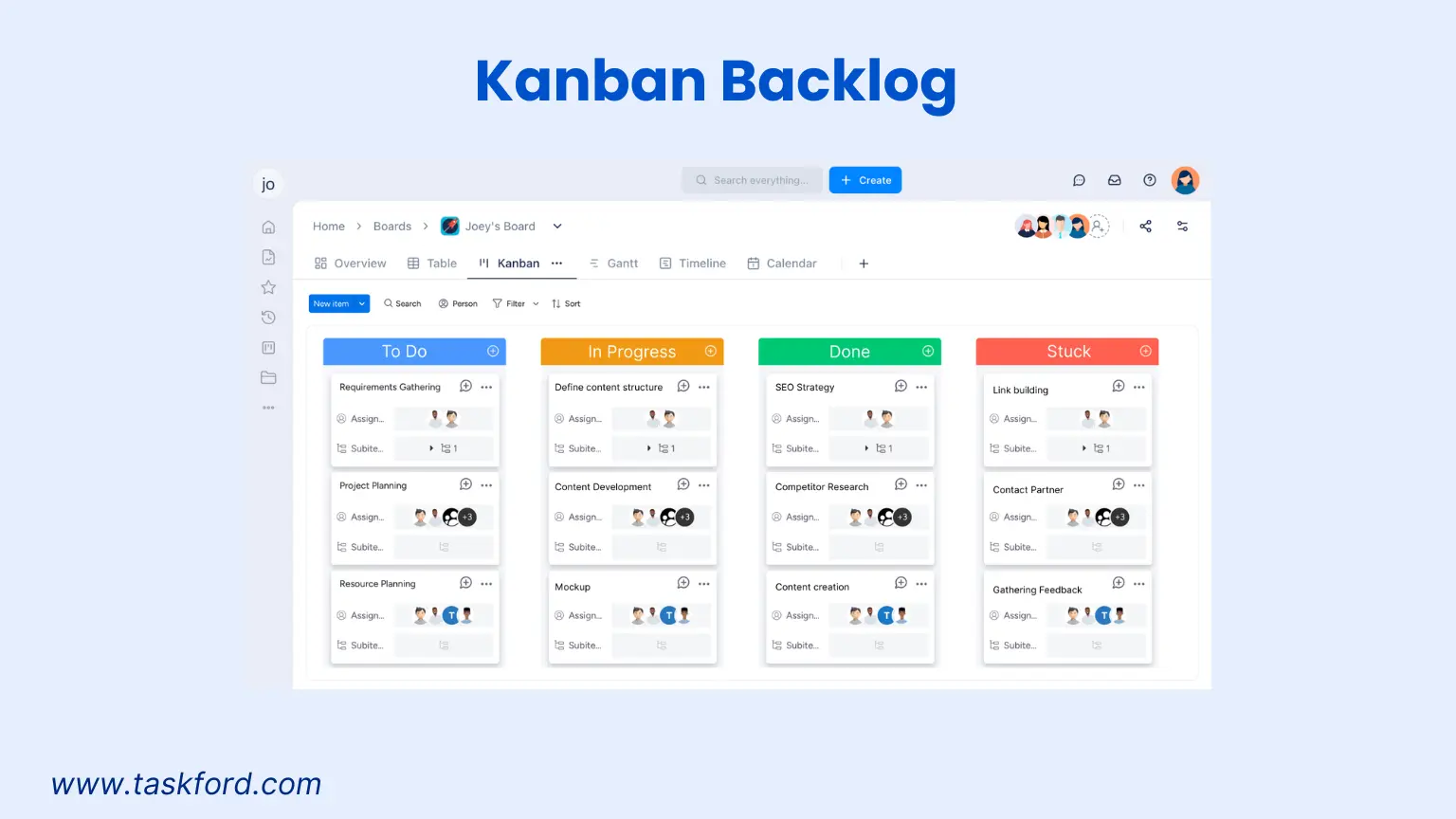Inside the Mind of an Agile Project Manager: Skills, Mindsets, and Daily Decisions
Discover the skills, mindset, and daily decisions that make agile project managers successful, and learn how TaskFord empowers them to deliver projects efficiently.
Agile project management has changed how teams tackle projects, focusing on flexibility, teamwork, and steady progress. The agile project manager is the key player, guiding teams through challenges with practical skills, a clear mindset, and smart daily decisions. This blog dives into what makes an agile project manager successful, covering their core abilities, thought processes, and choices. Whether you’re new to project management or looking to improve, this guide offers clear insights to help you succeed in this dynamic role.
What Does an Agile Project Manager Do?
An agile project manager leads teams using agile methods like Scrum, Kanban. Unlike traditional project managers who stick to rigid plans, they embrace change and encourage collaboration. They act as coaches, keeping teams focused while adapting to new needs. For example, if a client requests a new feature mid-project, they work with the team to adjust priorities without losing momentum.
This role is favored by many types of project managers by being suitable for dynamic, creative projects that require constant changes and improvements.
(Learn more: What Does A Project Manager Do?)
Key Skills of an Agile Project Manager
Agile project managers need a mix of practical and people skills to keep projects on track. Here’s a breakdown of their core abilities:

Guiding Teamwork
Agile project managers bring teams together, creating spaces where developers, designers, and stakeholders can share ideas freely.
- During daily stand-ups, they ensure everyone’s voice is heard.
- If someone’s stuck, they listen and help clear obstacles, like connecting a team member with an expert.
- They keep discussions focused, resolving conflicts without taking over.
Mastering Agile Methods
A deep understanding of Agile Methodologies is essential. They use Scrum’s sprints or Kanban’s task prioritization to keep projects moving.
- They might mix methods, like combining Scrum’s structure with Kanban’s flexibility.
- This tailored approach keeps teams aligned with project goals.
- They guide teams through iterative cycles, ensuring steady progress.
Adapting to Change
Change is part of the job, and they handle it with ease.
- If a client adds a new feature, they assess its impact and adjust plans.
- They consult the team to ensure changes don’t disrupt progress.
- Quick thinking keeps projects on track despite surprises.
Managing Stakeholders
Keeping everyone aligned is crucial. They balance the needs of clients, executives, and teams.
- They share updates using visuals like burndown charts.
- They gather feedback to ensure the project meets expectations.
- They manage requests without overwhelming the team.
Understanding Tech Basics
While not always coders, they know enough tech to talk with developers.
- In software projects, they might understand APIs or cloud systems.
- This helps them make smart decisions about tasks and resources.
- It bridges the gap between technical and non-technical team members.
The Agile Project Manager’s Mindset
The way an agile project manager thinks shapes their success. They approach challenges with a mindset that keeps the team and project moving forward.
Change isn’t a problem, it’s a chance to improve.
- When a client’s needs shift, they adjust priorities to deliver more value.
- They stay calm under pressure, helping the team see changes as opportunities rather than setbacks.
This flexibility is key to keeping projects on track in unpredictable environments.
They focus on supporting the team, not giving orders.
If a developer hits a roadblock, they might connect them with an expert instead of dictating a solution. This servant leadership builds trust and lets team members take ownership of their work. It creates a collaborative environment where everyone feels valued.
Continuous improvement drives them.
- After each sprint, they lead discussions to review what worked and what didn’t.
- They also seek growth through training or certifications like Certified ScrumMaster.
This commitment to learning keeps them sharp and helps the team grow stronger over time.
Keeping the customer first is at the heart of their approach.
They work closely with product owners to refine features and test them with users to ensure the project solves real problems. This focus ensures every decision delivers value to the end user.
A Day in the Life of an Agile Project Manager: Daily Decisions
An agile project manager’s day is full of choices that keep the project on track. Here’s a breakdown of a typical day:

Morning: Starting Strong
The day often starts with a daily stand-up meeting.
-
The team shares updates and flags any issues.
-
If a delay pops up, like a technical bottleneck, they decide how to fix it, maybe by reassigning tasks.
-
They review the project backlog, picking tasks for the next sprint with the product owner.
(Learn more: What Is a Backlog?)
-
They ensure the team’s workload is balanced to avoid burnout.
Midday: Tracking Progress
Throughout the day, they monitor tasks using key techniques.
- Timeboxing: Setting fixed time slots for tasks to stay focused.
- Backlog grooming: Prioritizing and refining tasks to align with goals.
- Burndown charts: Visualizing progress to spot delays early.
- If a sprint is at risk, they adjust tasks or discuss options with stakeholders.
- They manage risks, like a team member’s absence, by redistributing work.
Afternoon: Connecting with Stakeholders
Meetings with clients or executives often happen in the afternoon.
- They share progress and gather feedback.
- If a client wants a new feature, they weigh its importance and negotiate trade-offs.
- They ensure changes don’t disrupt the team’s rhythm.
- As a sprint ends, they review deliverables and plan improvements for the next cycle.
Evening: Wrapping Up
At day’s end, they reflect on progress and prepare for tomorrow.
- They update plans and respond to emails.
- They might explore industry trends to stay informed.
- This balances short-term tasks with long-term project goals.
How Agile Project Managers Differ from Others
Each type of project manager has a unique approach:
- Waterfall: Plans every step upfront, best for fixed projects like construction.
- PRINCE2: Uses strict processes, ideal for regulated industries like finance.
- Lean: Focuses on efficiency, common in manufacturing.
- Agile: Adapts quickly, perfect for tech or creative projects.
Agile project managers stand out for their ability to handle change and empower teams, making them ideal for fast-paced environments.
Techniques for Agile Project Managers
Agile project managers use simple techniques to stay organized:
- Timeboxing: Setting fixed time periods for tasks to maintain focus.
- Backlog grooming: Regularly prioritizing tasks to keep the project on track.
- Burndown charts: Tracking progress to see how much work remains.
These methods help them make clear, data-driven decisions.
Challenges Agile Project Managers Face
The role comes with hurdles:
- Scope creep: When stakeholders add requests, they balance these without overwhelming the team.
- Remote teams: Aligning virtual teams requires strong communication.
- Resistance to agile: Some organizations prefer traditional methods, so they must show agility’s value, like faster delivery and better teamwork.
How to Become an Agile Project Manager
Ready to start? Here’s how:
- Gain Experience: Try roles like project coordinator to learn the ropes.
- Learn Agile: Take courses or earn certifications like Certified ScrumMaster or PMI-ACP.
- Build People Skills: Practice listening, facilitating, and leading teams.
- Stay Current: Join groups like the Agile Alliance to keep learning.
How TaskFord Supports Agile Project Management
TaskFord is an advanced project management and resource planning platform that empowers agile project managers to keep projects organized and teams aligned. It offers features tailored to agile methodologies like Scrum and Kanban, making it easier to manage tasks, sprints, and resources effectively. Here’s how TaskFord supports agile project management:
-
Customizable Kanban Boards: TaskFord’s Kanban boards let teams visualize tasks and track progress in real time. Agile project managers can set up columns to match their sprint or Kanban process, helping everyone see what’s in progress and what’s next. This clarity keeps teams focused and makes it easy to adjust priorities when requirements change.
-
Sprint Planning and Backlog Management: TaskFord simplifies sprint planning with user-friendly tools for creating user stories and prioritizing tasks. Managers can use drag-and-drop features to plan sprints and refine the backlog, ensuring focus on high-priority items. This breaks complex projects into manageable steps, aligning with agile principles.

-
Gantt Charts and Timelines: TaskFord’s Gantt charts and timelines help managers track project progress and set task dependencies. They can monitor critical paths and spot risks early, ensuring sprints align with project goals. These tools provide visibility into both short-term sprints and long-term plans, even when requirements shift.

Conclusion
Being an agile project manager is both challenging and rewarding. By mastering agile methods, supporting their teams, and making smart daily decisions, they deliver projects that meet customer needs in fast-changing environments. Whether you’re starting out or aiming to improve, understanding this role can help you excel in project management. Check out TaskFord to boost your project management skills and take your projects to the next level.
Learn more
- Agile Project Management - The Basics For Beginners
- Agile Project Management Sprint Cycle - From Planning to Retrospective
- Real-World Agile Project Management with Scrum - Lessons from the TaskFord Team
Making work simpler,
smarter, and more connected
Join our waitlist and be notified first.

Subscribe for Expert Tips
Unlock expert insights and stay ahead with TaskFord. Sign up now to receive valuable tips, strategies, and updates directly in your inbox.






